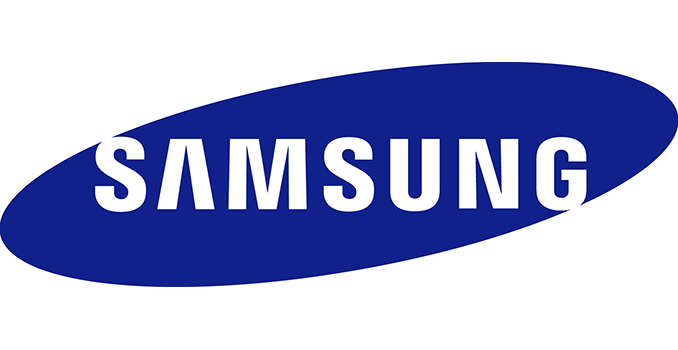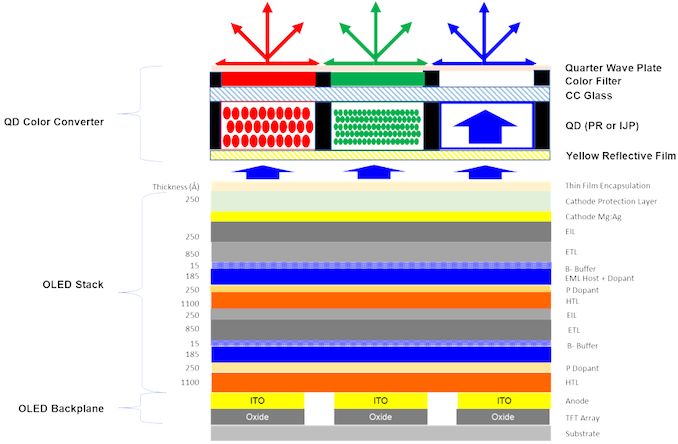Samsung to Invest $11 Billion in QD-OLED Panel Production
by Anton Shilov on October 15, 2019 5:30 PM EST
Samsung Display has announced plans to invest a further ₩13.1 trillion ($11 billion) in the R&D and production of QD-OLED TV panels. The plan includes building up two QD-OLED production lines in South Korea between now and 2025, with the first starting production in 2021. In addition, the company will invest in R&D of quantum dot-enhanced OLED technology, which promises to provide finer colors than today’s OLED displays and televisions.
The first step of Samsung’s QD-OLED plan will be converting its L8 fab in Tangjong, South Korea, from making LCD substrates to QD-OLED substrates. The plant is expected to produce 30 thousand QD-OLED substrates per month starting in Q1 2021. Longer term, Samsung will be converting all of its 8th Generation LCD production facilities to QD-OLED in a bid to increase the number of substrates produced monthly to 100 thousand.
The QD-OLED technology promises to simplify (i.e. lower the cost of) production of OLED-based televisions and monitors, as well as enabling wider color gamuts, which is something expected from next-generation content. Contemporary WOLED panels from LG Display use a blue or white (yellow + blue) OLED emitter stack, and a WRGB color filter system on top with a variety of additional layers behind, between, and ahead of them. By contrast, a QD-OLED panel uses an OLED emitter stack (some believe, with two emitting stacks) with a quantum dot RGB color filter (also called quantum dot color converter, or QDCC) system on top.
Today’s OLED panels feature 22 layers, whereas a QD-OLED panel may cut the number to 13, which means fewer deposition stages, lower material and production costs, and, perhaps, better yield. The QD-OLED technology is still considered to be rather challenging as Samsung has to solve light management issues. Meanwhile, according to Display Supply Chain, one square meter of an QD-OLED panel will cost around $26, whereas one square meter of a contemporary OLED panel costs approximately $95.
Lee Dong-hoon, CEO of Samsung Display, had the following to say:
"Quantum dots are semiconductor particles which luminate close to natural colors. It is the future growth vision of the large display industry. With the investment we will lead the premium display market."
Related Reading:
- Samsung Mulls Suspending South Korea LCD Plant Due to Oversupply
- Samsung Acquires Quantum Dot Tech Company QD Vision
- Samsung’s 8K QLED TV 55-Inch: A More Affordable 8K Ultra-HD TV
- 8K Association Sets Minimal Specs for 8K Ultra-HD TVs
- Sharp to Demonstrate 120-Inch 8K LCD TV & 8K TV with 5G Modem at IFA
- AU Optronics's New 85-Inch 8K LCD TV with 1,024-Zone Backlighting
- Samsung's 2019 QLED UHD TVs: 8K TVs Revamped, 4K TVs Get New Panel & Backlighting
Sources: Reuters, Nanosys, The Investor, Nikkei, DSCC, OLED-Info












42 Comments
View All Comments
Death666Angel - Tuesday, October 15, 2019 - link
So, kind of like an LCD but with [number of pixels] amount of local backlight dimming available? At least to me, reading this article, the QDCC seems like the crystals in LCDs and the OLEDs are providing the backlight. This should eliminate burn in, give us basically full array local dimming, but will not have as fast a pixel response time as plain OLED. Right? Seems good enough to replace LCDs with LED backlights as an intermediate step, though.s.yu - Tuesday, October 15, 2019 - link
It's the same as current WOLED in this respect, only using a single frequency backlight with a QD converter should result in much higher energy efficiency as well as better color saturation compared to using blue and yellow to output white then using a LCD filter. I don't see this eliminating burn-in though, frequently used diodes still age faster.wr3zzz - Tuesday, October 15, 2019 - link
I am wondering about the burn-in issue as well. Many articles, without citing sources, claim QD-OLED will not have burn-in but since its emitter is still OLED how does this make sense?boeush - Tuesday, October 15, 2019 - link
Assuming a higher efficiency of the overall stack, each individual diode won't have to work as hard to output a given quantity of light. So, on an iso-lumen basis, the pixels should just last longer because they won't have to be driven as hard.s.yu - Tuesday, October 15, 2019 - link
I see, of course that makes sense, nowhere near burn-in free, just equivalent to the burn-in at a lower brightness.FXi - Wednesday, October 16, 2019 - link
Even more fun is that QD's (organic) also have a wear out rate. But frankly the voting on picture quality vs lifespan has clearly gone (by means of market sales) in favor of quality. I suspect Samsung's bet here is basically the same as Nand's take on QLC. If the cost can be made low enough people won't care if it doesn't last forever, as long as it looks great. And colors should be much better than the LG method. High wavelength light however (if it leaks in any way) is bad for eyeballs however.peevee - Wednesday, October 16, 2019 - link
"High wavelength light however (if it leaks in any way) is bad for eyeballs however."You mean high frequency (=low wavelength)?
And there is nothing bad about blue light if it is indeed the light directly used to represent blue subpixels - we are adapted for it. Nobody gone blind from simply looking at blue sky which has much higher brightness than any TV.
eastcoast_pete - Wednesday, October 16, 2019 - link
If you're correct (I believe you are), then that's too bad. My screen is bright, used for work 10-14 hours/day, much of it with static frames etc. I guess it's quantum-dot IPS or VA panels for me for another couple of years.Zizy - Wednesday, October 16, 2019 - link
It won't help vs WOLED, but against Samsung's current OLEDs it will be better because all pixels will wear out at the same rate - so (parts of) picture will get dimmer but not different color than before. Because all pixels are the same, it is also much easier to do compensation - start somewhat dimmer than maximum and increase current through lifetime.On the flip side, you can't have bigger blue pixels than green ones because the backlight is blue for all.
Diogene7 - Tuesday, October 15, 2019 - link
@Death666Angel : I don’t know if it is correct, but indeed it is my understanding as well that is more some sort of Quantum Dot (QD) display with white OLED backlight for each pixelI think that smartphone OLED display use RGB OLED pixels : so there are 3 sub-pixels that each independently produce the 3 primary colors Red, Green and Blue, which in theory, seems the best in terms of quality I think.
I think the very first generation of Samsung OLED TV in 2013 was using a RGB OLED technology but as it wasn’t price competitive compare to LG WRGB OLED TVs, Samsung unfortunately stop the production :(...
I would love to see flexible RGB OLED scale to TV size : it would offer the possibility to create large OLED panel that are lightweight and that should have a very good image quality, right ?